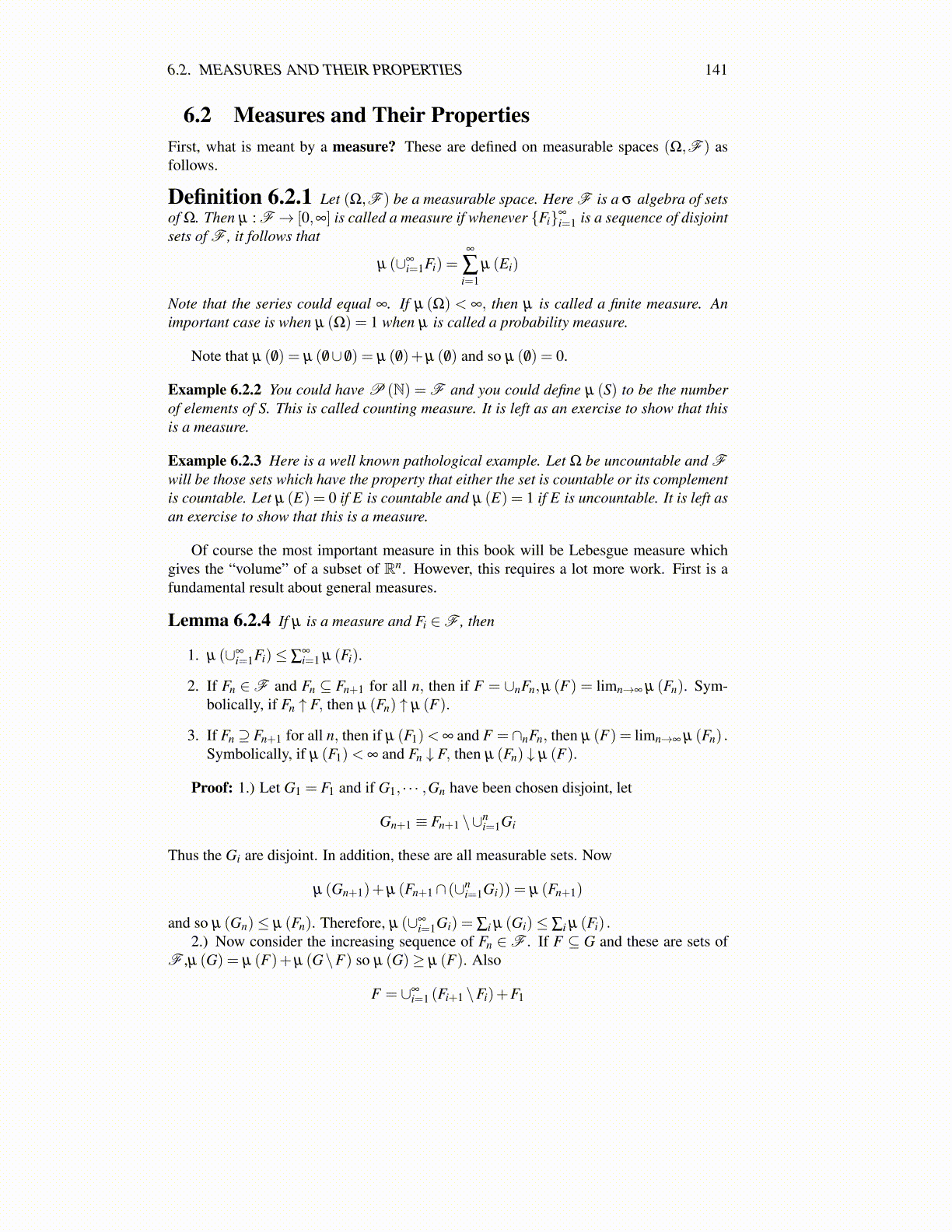
6.2. MEASURES AND THEIR PROPERTIES 141
6.2 Measures and Their PropertiesFirst, what is meant by a measure? These are defined on measurable spaces (Ω,F ) asfollows.
Definition 6.2.1 Let (Ω,F ) be a measurable space. Here F is a σ algebra of setsof Ω. Then µ : F → [0,∞] is called a measure if whenever {Fi}∞
i=1 is a sequence of disjointsets of F , it follows that
µ (∪∞i=1Fi) =
∞
∑i=1
µ (Ei)
Note that the series could equal ∞. If µ (Ω) < ∞, then µ is called a finite measure. Animportant case is when µ (Ω) = 1 when µ is called a probability measure.
Note that µ ( /0) = µ ( /0∪ /0) = µ ( /0)+µ ( /0) and so µ ( /0) = 0.
Example 6.2.2 You could have P (N) = F and you could define µ (S) to be the numberof elements of S. This is called counting measure. It is left as an exercise to show that thisis a measure.
Example 6.2.3 Here is a well known pathological example. Let Ω be uncountable and Fwill be those sets which have the property that either the set is countable or its complementis countable. Let µ (E) = 0 if E is countable and µ (E) = 1 if E is uncountable. It is left asan exercise to show that this is a measure.
Of course the most important measure in this book will be Lebesgue measure whichgives the “volume” of a subset of Rn. However, this requires a lot more work. First is afundamental result about general measures.
Lemma 6.2.4 If µ is a measure and Fi ∈F , then
1. µ (∪∞i=1Fi)≤ ∑
∞i=1 µ (Fi).
2. If Fn ∈F and Fn ⊆ Fn+1 for all n, then if F = ∪nFn,µ (F) = limn→∞ µ (Fn). Sym-bolically, if Fn ↑ F, then µ (Fn) ↑ µ (F).
3. If Fn ⊇ Fn+1 for all n, then if µ (F1)< ∞ and F = ∩nFn, then µ (F) = limn→∞ µ (Fn) .Symbolically, if µ (F1)< ∞ and Fn ↓ F, then µ (Fn) ↓ µ (F).
Proof: 1.) Let G1 = F1 and if G1, · · · ,Gn have been chosen disjoint, let
Gn+1 ≡ Fn+1 \∪ni=1Gi
Thus the Gi are disjoint. In addition, these are all measurable sets. Now
µ (Gn+1)+µ (Fn+1∩ (∪ni=1Gi)) = µ (Fn+1)
and so µ (Gn)≤ µ (Fn). Therefore, µ (∪∞i=1Gi) = ∑i µ (Gi)≤ ∑i µ (Fi) .
2.) Now consider the increasing sequence of Fn ∈F . If F ⊆ G and these are sets ofF ,µ (G) = µ (F)+µ (G\F) so µ (G)≥ µ (F). Also
F = ∪∞i=1 (Fi+1 \Fi)+F1